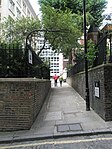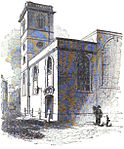St Mary Bothaw
10th-century church buildings in England1666 disestablishments in EnglandChurches destroyed in the Great Fire of London and not rebuiltChurches in the City of LondonFormer buildings and structures in the City of London ... and 3 more
London church stubsUnited Kingdom Anglican church building stubsUse British English from May 2012

St Mary Bothaw (or Saint Mary Boatehaw by the Erber) was a parish church in the Walbrook ward of the City of London. It was destroyed in the Great Fire of London in 1666 and not rebuilt, although some of its materials were used in the rebuilding of St Swithin, London Stone, whose parish it was merged with.
Excerpt from the Wikipedia article St Mary Bothaw (License: CC BY-SA 3.0, Authors, Images).St Mary Bothaw
Upper Thames Street, City of London
Geographical coordinates (GPS) Address Nearby Places Show on map
Geographical coordinates (GPS)
| Latitude | Longitude |
|---|---|
| N 51.51 ° | E -0.088888888888889 ° |
Address
Upper Thames Street
Upper Thames Street
EC4R 3BF City of London
England, United Kingdom
Open on Google Maps











